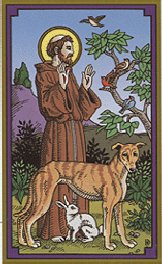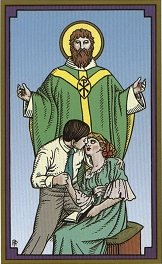The Tarot deck was designed for games, and when supernatural
powers are attributed to them by a card reader, they are merely
being used as props for lay counselling.
French Tarot is the second most popular card game in France.
Click here for the rules.
Here, who deals each hand doesn't matter. Everybody gets 24 cards.
The six cards left over are "the dog". Make your bid.
Here if you pass, one of the other players will usually bid. If nobody
bids, a new hand will be dealt.
"Small -- use" lets you trade six cards from your hand for the unused
cards ("dog"), and include the cards you discard for your score.
"Big -- use" is the same except the score (positive or negative) is mutiplied by two.
"Big -- keep" is the same except you leave the dog alone but still get the points,
and the score is multiplied by four. "Big -- discard" is the same except you
do not get the points for the dog at all, and your score is multiplied by six.
How many card points you need depends on how many you get among the magician, the world, and
the fool.
In the play for tricks,
the player counter-clockwise from the taker plays first.
The "Major Arcana" are always
trumps. Play goes counter-clockwise. You must follow the suit led if you can,
and if you cannot, you must play a trump if possible. If you play a trump and there
is already a trump in the trick, you must play a higher trump if you can.
The trick is taken by the player of the highest-numbered trump, or if no trumps
are played, by
the highest card of the suit led. All minor suits rank from top to bottom KQJX98765432A.
However, if you have The Fool you may play it instead of following suit or trumping.
If you lead the Fool at the beginning of a trick, the next player can play any card.
The second card played to that trick defines the "suit led" for the trick.
The Fool remains your property for scoring except as noted below.
The Fool wins a trick if and only if it is played on the last trick and and
the side playing the Fool has won all previous tricks.
If you play the Fool to the last trick and your side has not won all the previous
tricks, then the Fool becomes the property of the opponents.
"Least-at-last" was implemented in this way. If the taker wins the last trick
with the magician, the taker's score gets +10 before multiplication.
If a defender wins the last trick with the magician, the taker's score gets -10
before multiplication.
I handled "handfuls" by assuming the taker will always declare any handful (10 or more trumps),
double handful (13 or more trumps) or triple handful (15 or more trumps.)
The declared number of trumps are revealed to the other players.
If one player takes all the tricks, there is a bonus of +200, and a penalty of -100 for each of the other players.
I have not yet included the special rules for misery or announced slams.
In scoring cards taken in tricks, I followed the usual way
counting
card points in tarot games.
Count 1 point for each trick taken (group of three in the extra cards).
Add 4 for each of I, XXI, Kings, and the Fool,
3 for each queen, 2 for each knight, and 1 for each page.
It seems most reasonable to me to think that the Tarot began as playing cards, for entertainment and games, when sufficiently sturdy paper / pasteboard was invented. The suit cards are like our own playing cards.
The trumps present common interfaith symbols that people from many traditions have found helpful in reflection and meditation.
My own experience has been that this can perhaps improve your life if (and only if) your intention is to stop focusing on life's "small stuff" and prepare you to be kind to those around you.
If there are really any intricate cosmic secrets here, I have
been unable to understand them.
Call me dumb or unspiritual if you like.
When I have actually seen the cards used for divination by practitioners,
they were obviously being used as mere props for lay-counselling.
Kings would rank highest, then queens.
Chivalric knights were sworn to serve queens, and pages were squires
to knights. In the trump suit, notice how often a card seems naturally
to take precedence over the one just below it. No reasonable person would deny that the cards are beautiful and meaningful, or claim that this is just a more complex version of "scissors, paper, stone".
* If, as in the old decks, the tower is the "House of God", then the Church defeats
the devil, and nothing below the heavens can take precedence over the Church.
As a kid, I spent quite a bit of time
with Waite's book and the tarot pack. I wondered about his hints
that he possessed
great secret knowledge. (Re-read his description of the "Hanged Man",
look closely at the Ace of Cups,
recall that in his own life he professed the Christian faith,
and then draw your own conclusions.) Today I appreciate him most as the first person
to write systematically about the western occult tradition.
At least some of his Golden Dawn fellow-seekers of "secret knowledge" eventually
found the Ignatian "Spiritual Exercises" more helpful.
Tarot Game Rules -- links to more complicated games with bidding
Waite's Tarocky



The "Latin" suits may represent the military and government (swords),
the clergy (cups),
the business folks (coins),
and the laborers (staves).

The Magician ("juggler", "mountebank" or "sleight of hand artist") may have been introduced first, as a wild card like
our joker for some card games.

The High Priestess was a female pope ("la Papesse"). When it was decided
to introduce a second wild card, a female trickster might have been chosen as the
magician's counterpart. The legend of "Pope Joan" may have attached
itself to the card.

The next three cards may have been introduced together. The Empress would have precedence over the previous two cards, and the four Kings.

The Emperor, of course, is lord over the Empress. The Holy Roman Empire was in existence when the cards were developed.

The Hierophant is probably the Pope, to whom the Emperor owed obedience, at least in theory.

Romantic love has power over every human being. Waite called the first five cards "the captives of Cupid."

War interrupts the lives of Lovers and can take love even out of the human heart.
I've been told that the bonds between comrades-in-arms are stronger than between Lovers.

Strength ("fortitude") gives victory over the enemy Chariots. Socrates's four temporal virtues (fortitude, justice, temperance, and perhaps wisdom / judgement) may all be represented in the images.

The Hermit may originally have been Father Time, who wears down all Strength.

The Wheel of Fortune, or the cycle of Luck, operates through all Time and over the years.

Justice, rather than Luck, should determine what happens to a person.

The Hanged Man is a mystery. Perhaps this is an extrajudicial lynching.
Perhaps this is a cryptic representation of the One Who fulfilled the demands of the law's Justice by His death.

Everything represented up to now is subject to human mortality.

Temperance, living a wholesome life, gives the best chance of staying
healthy and avoiding premature Death.

The devil tempts us to live in ways that are not temperate or otherwise wholesome.

At the destruction of the Tower of Babel, the devil's agents were dramatically defeated. *

The Star shines high above all Towers.

The Moon outshines the Stars.

The Sun outshines the Moon.

At the Last Judgement, the Sun and all rest of creation will disappear.

A card representing a Fool (simpleton) was probably introduced to be playable at any time.

The World contains all the things that can possibly be, and
so it is the highest of all cards. Perhaps this is the
new World that will follow the Last Judgement.
Tarot History
Various Tarot Decks
Tarocchino -- downloadable book of tarot games. No-nonsense account of the history of the gaming cards and the bunko artists who made it an "occult mystery." Thanks!
The Castle of Crossed Destinies -- "semiotic fantasy novel"

Francis of Assisi
Christian Tarot Decks
Tarot and Evangelism -- prof at U. of Aberdeen divinity school. Like any evangelist, meeting "New Agers" where they already are.
Tarot of the Saints -- Biblical and historical images, some gnosticizing
Tarot of the Saints -- Amazon
Tarot of the Saints -- Margaret of Rome resists the devil, etc.

VI. The Lovers
Danish Tarot
French Tarot for Four
German Cego
Hungarian Tarot
Konigrufen -- complicated, casual tarot game
Swiss Troccas
Scarto -- primitive tarot game
Bid Tarot -- primitive tarot game with bidding